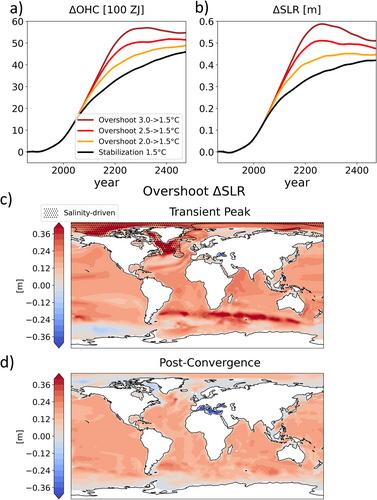Persistently Elevated High-Latitude Ocean Temperatures and Global Sea Level Following Temporary Temperature Overshoots
Abstract
As exceeding the 1.5°C level of global warming is likely to happen in the near future, understanding the response of the ocean-climate system to temporarily overshooting this warming level is of critical importance. Here, we apply the Adaptive Emissions Reduction Approach to the Earth System Model GFDL-ESM2M to conduct novel overshoot scenarios that reach 2.0, 2.5 and 3.0°C of global warming before returning to 1.5°C over the time period of 1861–2500. We also perform a complementary scenario that stabilizes global temperature at 1.5°C, allowing to isolate impacts caused by the temperature overshoots alone, both during their peaks and after their reversals. The simulations indicate that substantial residual ocean surface warming persists in the high latitudes after the overshoots, with most notable regional anomalies occurring in the North Atlantic (up to +3.1°C in the 3°C overshoot scenario compared to the 1.5°C stabilization scenario) and the Southern Ocean (+1.2°C). The residual warming is primarily driven by the recoveries of the Atlantic and Southern Ocean meridional overturning circulation and associated increases in ocean heat transport. Excess subsurface heat storage in low and mid-latitudes prevents steric sea level rise (SLR) from reverting to 1.5°C stabilization levels in any overshoot scenario, with steric sea level remaining up to 32% higher in the 3°C overshoot scenario on centennial time scales. Both peak impacts and persistent changes after overshoot reversal bear significant implications for future assessments of coastlines, regional climates, marine ecosystems, and ice sheets.


 求助内容:
求助内容: 应助结果提醒方式:
应助结果提醒方式:


